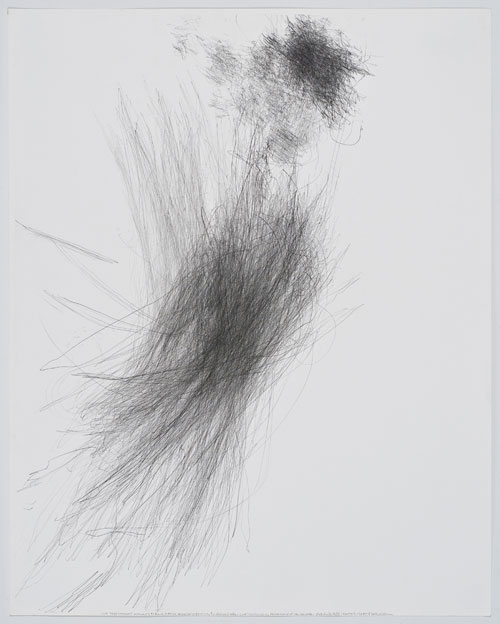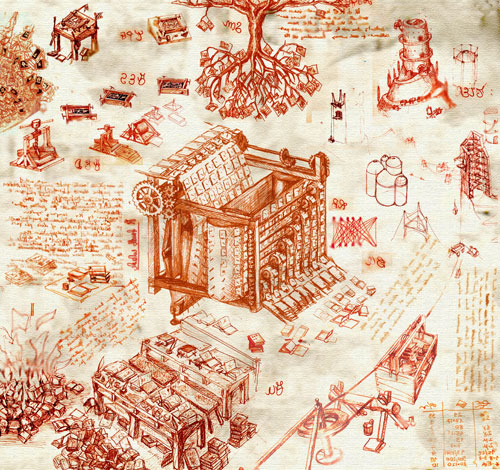
Morgan O’Hara. LIVE TRANSMISSION: movement of Peter Gregson performing on electronic cello, 2010. Graphite on Bristol paper, 65.5 x 81 cm. © Morgan O’Hara.
Rugby Art Gallery and Musuem
6 September–30 October 2011
by MK PALOMAR
Described as a “primacy”,1 a “history of experience,” a “means of searching for identity”,2 and an “instinctive activity as fundamental to human life as eating and drinking”,3 drawing might perhaps be understood as humankind’s innate desire to mark or map evidence of self in relation to the other
This instinctive process is as “old as song” and can be described as a method of “discovery”.4 Perhaps marking surfaces (the method of conventional drawing) began with a toe pressed into sand, or a stick trail through mud for others to follow; today practitioners expand the idea of drawing beyond a surface. Makers, thinkers and dreamers, now explore time based media, sound and space as materials to draw with and through; and this process is no longer confined to fine arts but occurs throughout all types of disciplines. Just as drawing itself exists within many areas of humankind’s manufacture, curator and writer on drawing Catherine de Zegher observes that definitions of the English word draw “seemingly permeate many aspects of life”. “To draw out, (to extract … to outline) to draw from, (to abstract) to draw in, (to entice) to draw down, (to deplete) to draw up, (to draft into form) and so on”.5 If we understand drawing as a method of intentionally marking or moving through surface and or place, then the process of drawing is woven very deeply into our lives within industry, language, memory, dreaming and so on.

Sergio Cittolin. Data Acquisition Machine, 2009. Pen, ink and digital processes, 41 x 44 cm. © CERN physicist Sergio Cittolin.
Rugby Art Gallery and Museum’s The 43 Uses of Drawing, curated by the practitioners’ researchers and teachers Paul Cureton and Craig Staff, “explores the practice of drawing beyond the paper surface, via the work of 43 practitioners working in a number of different areas. A revived interest in drawing has brought the discipline to the forefront of contemporary arts”.6 This revival (which has seen around a dozen publications over the past decade in the UK alone7) may or may not be a repercussion affected by the contemporary preference for concept over artefact, and digital over analogue. Yet debating such topics is in danger of getting stuck when hooked on what has already become an old chestnut, the haptic verses (computer) mouse value debate. It is more constructive to appreciate that drawing has broken loose from its fine art confines and is now beginning to be recognised as a valuable process with interesting cross and multi disciplinary repercussions. As curators Cureton and Staff underline, “The aim of the exhibition is to ignite the debate and discussion by mapping the different practices and uses of drawing across disciplines and beyond the boundaries of fine art”. There have been a number of previous valiant stabs to redress this collective blindness towards the democracy of drawing, notably Andrew Graham Dixon’s 2006 BBC TV series The Secret of Drawing, and in 2010 a series of booklets for Visual Learning in Higher Education8.
-b.jpg)
Tony Maidment. Engraving for 500 Sum bank note Uzbekistan (back). Engraving on paper, 21 x 30 cm. © Tony Maidment.
Igniting debate by mapping different uses of drawing is exactly what this exhibition so eloquently achieves, by-passing the screen verses handmade old chestnut by navigating the uses of drawing through examples of excellent practice from very diverse disciplines. There is Buckminster Fuller’s 1943 presentation of the Dymaxion Projection of the World Map; Morgan O’Hara’s 2009 Line Transmissions; tracing the motion of hands conducting and performing Mozart’s Piano Concerto in E flat major. Physicist (in change of trigger and data acquisitions at CERN) Sergio Cittolin’s Event Analysis (2009), Dr Tariq Ahmad’s Drawings for Surgical Procedures (2007), performance artist Bobby Baker’s Diary Drawings (1997–2008), and Ben Fry’s Genome Vallance; Software Sketch Computer Visualisations (1999) to name a small handful of this fascinating collection of practitioners and their works. And all the various disciplines exampled in this rich collection employ the necessary process, which enables us wherever we are and whatever our profession, to develop our ideas and observations and put them into the world. If you have a serious interest in drawing, its process, expansion, uses and democracy, and want to see a really broad and rich example of how diverse our “instinctive activity” can be, then don’t miss The 43 uses of Drawing. It is a very engaging exhibition and an important contemporary reflection of where we are and what we are doing in the world.
References
1. Deanna Petherbridge, The Primacy of Drawing; histories and theories of practice, Yale University Press: 2010.
2. Carl Plackman Artists Statement 1972–78. Page 17.
3. Andrew Graham-Dixon, The Secret of Drawing series of four TV programmes; 1) The Line of enquiry, 2) Storylines, 3) All in the Mind, 4) Drawing by Design. BBC October 2006. Storylines is available on YouTube
4. John Berger, Berger in Drawing, Cork, Occasional Press: 2007: 3 & 109.
5. Transcribed by the author from notes and audio recordings made during the conference With A Single Mark, Tate Britain, 19 May 2006.
6. Extract from Rugby Art Gallery and Museum’s Press Release.
7. Michael Craig Martin- Drawing the Line, South Bank Centre exhibitionand catalogue:1995
L. Hopman, Drawing Now Eight Propositions, MoMA New York: 2002.
C. de Zegher and A. Newman, The Stage of Drawing Gesture and Act. Tate Publishing and The Drawing Centre:2003
E. Dexter, Vitamin D New Perspectives in Drawing.Tate Modern: 2005
A. Graham- Dixon, The Secret of Drawing BBC TV 4 part series: 2006
C. Darwent, The Drawing Book: A survey of Drawing the Primary Means of Expression, ed Tania Kovats, Black Dog Publishing: 2007
B. Dillon, The End of the Line: Attitudes in Drawing, Hayward Gallery: 2009
L. Duff and P. Sawden, Drawing the Purpose, Intellect Books: 2009 C. de Zegher and C. Butler, On Line: Drawing through the 20th Century, MoMA New York :2010
D. Petherbridge, The Primacy of Drawing. Yale: 2010
S. Garner, Writing on Drawing: Essays on Drawing practice and Research. Intellect Books: 2011
M. Maslen and J. Southern. Drawing Projects: an Exploration of the language of drawing. Black Dog: 2011.
Paul Cureton and Craig Staff have curated the exhibition at the Rugby Art Gallery and Museum. 6th September 30 Oct 2011. The 43 Uses of Drawing “explores the practice of drawing beyond the paper surface via the work of 43 practitioners working in a number of different areas ... demonstrating both the breadth of drawing today and its continued relevance to contemporary art practice and the wider creative industry”. Extract from online press release accessed 30/08/11.
8. Dr Angela Rogers and Pauline Ridley have completed an important study at Brighton University on Visual learning in Higher Education, the four booklets they produced as a resource for staff and student on learning development titled Drawing to Learn, cover a broad range of disciplines: Business, Education, Law, Management and Social Science; Science, Technology, Engineering and Maths; Arts and Humanities; Clinical Education Health and Social Care. These booklets were published by The Centre for Learning and Teaching at the University of Brighton in 2010.